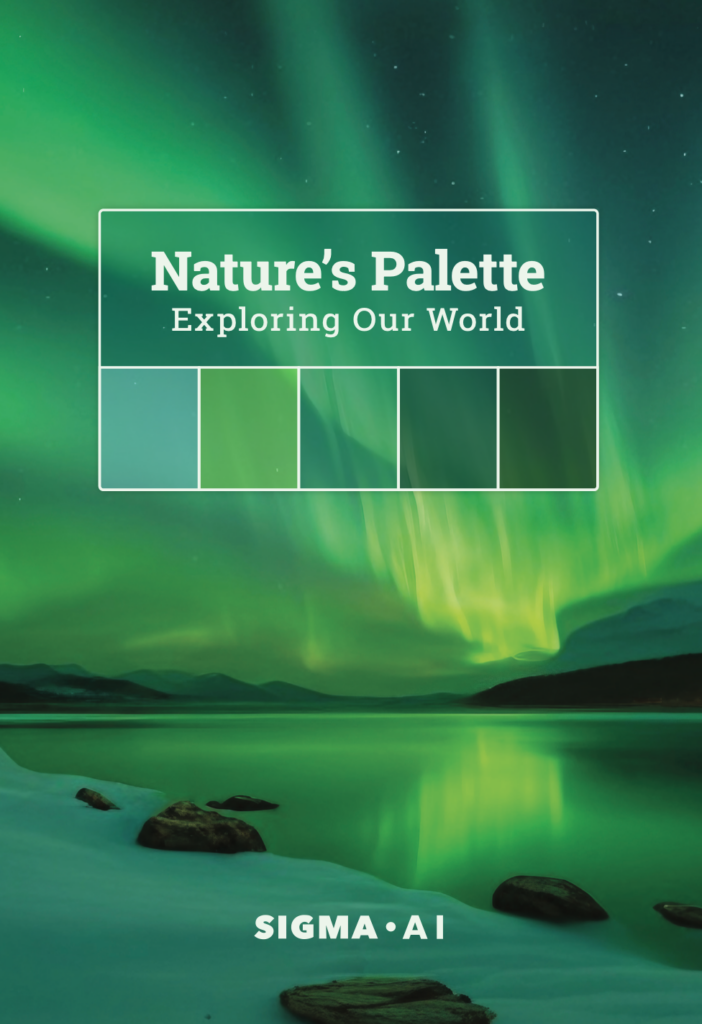The concept: Blending art, science, and AI
We began by brainstorming coffee table book ideas that would appeal to a broad, international adult audience. AI generated a host of possible topics and then provided additional data on the popularity of certain topics and categories.
Humans narrowed these options down to the most appealing. A book on nature aligns with Sigma’s commitment to sustainability, while offering endless opportunities to showcase the power of AI-generated imagery and text. We envisioned a book that would take readers on a visual journey through lesser-known flora, fauna, and natural phenomena across every continent.
The AI workflow: Generating and refining ideas and content
Creating an AI-generated book requires more than just feeding prompts into a model. We used a Human-in-the-Loop (HITL) approach, with the human guiding AI and curating responses at each step, while the AI generated each element in a structured, iterative process:
1. Ideation and topic selection
We asked AI to generate a long list of unique plants, animals, and natural features, prioritizing subjects with striking visual elements and rich storytelling potential. Next, we asked AI to sort these by continent and ensure wide geographic representation, as well as representing a diverse mix of subjects.
2. Image generation and annotation
We used AI image generation tools to create photorealistic visual representations of the selected subjects. Humans reviewed the output against real images to verify that they were realistic representations of the actual species and landscapes. In some cases, we used AI tools to refine the images, such as cleaning up or removing excess elements. We also used AI to enhance, uncrop (extend the image area), and upscale images to higher resolution.
3. Text generation and editing
We used generative AI to synthesize scientific and factual information into engaging, digestible descriptions. We also asked AI to mix in cultural aspects such as history, human influences, cultural significance, or endangered species status. Human experts fact-checked and refined these descriptions, ensuring scientific accuracy, narrative clarity, and proper context.
4. Design and layout
We laid out the book’s pages with the AI-generated images and text, and added in AI-selected color palettes based on the images to create an elegant, visually cohesive design for each spread. The final product is a 7×10-inch, full-color hardcover book designed to be both aesthetically pleasing and intellectually engaging.

The human touch: Why data annotation matters
While generative AI is remarkably powerful, it is not infallible. Left unchecked, AI can produce factual inaccuracies, repetitive or needlessly emphatic content, visually implausible images, and descriptions that lack nuance. This is where human data annotation is essential.
Human data annotators play a critical role in training large language models through the human’s subject matter expertise, cultural context, and creativity. This human input ensures that the LLM will provide:
- Scientific accuracy — verifying species names, ecological facts, and geographic details.
- Accurate visual outputs — correcting anatomical inconsistencies in AI-generated animals and improving the realism of landscapes.
- Engaging readability — ensuring AI-generated text is compelling and accessible to a general audience.
This book is an experimental combination of art and science, humans and machines. It also demonstrates generative AI’s capabilities and proves that high-quality AI outputs require expert human oversight. Whether applied to a coffee table book or to developing the standards for AI data annotation for our clients, human-in-the-loop (HITL) processes continuously validate and refine results for quality, accuracy, and relevance.
The final product: A testament to AI & human collaboration
Nature’s Palette: Exploring Our World is more than just a visually stunning book — it is a showcase of how AI and human expertise can work together to produce something extraordinary. Each spread in Nature’s Palette features:
- A high-quality, AI-generated image of a rare or fascinating natural subject.
- A color palette derived from the image by AI, reflecting the unique hues found in nature.
- A short, AI-generated description with scientific and cultural insights about the subject.
For technology leaders considering the value of human data annotation, this project underscores a fundamental truth: AI alone is not enough. The best AI-generated content is created when expert humans guide, refine, and enhance its outputs. At Sigma AI, our expert project managers create feedback loops to iteratively improve quality results.
We invite you to explore Nature’s Palette for yourself as a source of inspiration to explore the world in person — or from your favorite chair.
The creation of an AI-powered book shows the incredible potential of gen AI, but it relies on humans to train for nuance and ensure safety. Explore the specific techniques required to imbue models with complex human judgment and creativity in Human touch in gen AI: Training models to capture nuance. To ensure your creative models produce safe, non-toxic content, review our advanced safety validation services on our Services – Protection page.
Partner with Sigma to infuse human judgment into every stage of your gen AI workflow.
